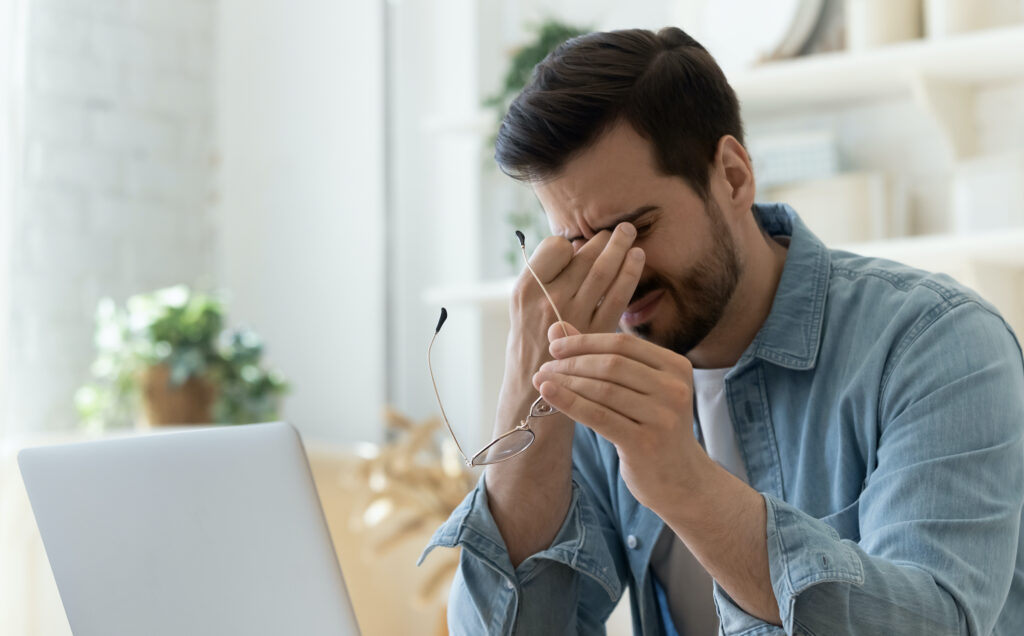Dry Eye
Dry Eye Disease
Dry eye disease is becoming increasingly common, affecting millions of people worldwide. This chronic condition can significantly impact your life, sometimes making even the smallest of tasks seem difficult.
If you have eye pain, blurry vision, and dry or watery eyes, it could be a sign that you have dry eye disease. But don’t worry! With an in-depth eye exam, our team can assess your vision and eye health to get you the treatment you need.
What Is Dry Eye Disease?
Dry eye disease is a common eye condition that occurs when there is an issue with any one of the three components of your tears. Your tears are made up of 3 distinct layers, all of which work together to keep your eyes healthy:
What are the 2 Types of Dry Eye Disease?
Evaporative Dry Eye (EDE)
EDE is the most common type of dry eye disease. This type of dry eye occurs when you lack the proper amount of oil in your tears. When this happens, your tears can evaporate too quickly, drying out your eyes.
In some cases, EDE can be caused by meibomian gland dysfunction, a disorder where the meibomian glands in your eyes become blocked, limiting the amount of oil being produced for your tears.
Aqueous Tear Deficiency (ATD)
If you suffer from ATD, your eyes lack the aqueous layer in your tears. This means that your eyes aren’t producing enough tears to keep the eye moist, which can lead to irritating and uncomfortable symptoms.
A customized treatment plan can be determined once the severity and cause of your dry eye is determined.
Tear Supplements
Tear Supplements involve finding the correct balance of nutritional supplements and preservative free artificial tears and gels to balance the tear deficiency. At your visit, the doctor will select the right products for your level of dry eye and for your convenience, most of these items can be purchased from our dry eye stores in office or online at dryeyerescue.com.
Tear Retention is another approach to treating dry eye holding on longer to the natural lubricating tears your eye is producing. Temporary punctum plugs are inserted into the small drain holes found in the upper and lower inner corners of your eyelids. If the temporary punctal occlusion brings relief a more permanent silicone plug can be used.
Meibomian Gland Treatments
Meibomian Gland Treatments will be recommended if Meibomian Gland Dysfunction is diagnosed. Eye lid scrubs aid in good lid hygiene and removing debris. Warm compresses, if used daily, can help liquefy oil in the meibomian glands. Some patients find these daily treatments a challenge. Our doctors can help MGD with in office treatments as well. A Zest (Zocular Eyelid System Treatment) gently exfoliates the eyelids to restore the natural state of the eyelids. By opening up the meibomian glands, it helps release oils into the eye that help to balance the natural lubrication of the eye. For more advanced MGD your doctor could recommend IPL treatments.
If your eye doctor has recommended the OptiLight treatment, they will go over everything you can expect before, during, and after your appointment.
The OptiLight Treatment
This treatment is fast and simple, taking only 10–15 minutes. During your treatment your doctor will apply a cool gel on the treatment area and cover your eyes with shields to protect them. As light is applied to the skin, you may experience a warm or a tapping sensation, but you shouldn’t feel any pain.
Post-Procedure Care
While side effects are uncommon, your eyes may feel slightly more dry or gritty for the day following your procedure. If you do experience dry eyes, you can use preservative-free artificial tears.
Following your treatment, your skin will be sensitive, so we recommend avoiding sun exposure and wearing sunscreen.
How do you know if OptiLight is the right treatment for you? During an eye exam, your doctor can determine whether or not it is the right option for you. In general, OptiLight isn’t recommended for patients who:
You don’t have to live with the uncomfortable symptoms of dry eye disease. With OptiLight by Lumenis, your symptoms can be managed effectively and efficiently, restoring your quality of life.
Our team is always here to help you find relief from dry eyes. Request an appointment today to see how OptiLight by Lumenis can help you!







